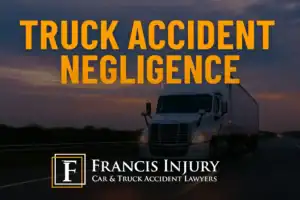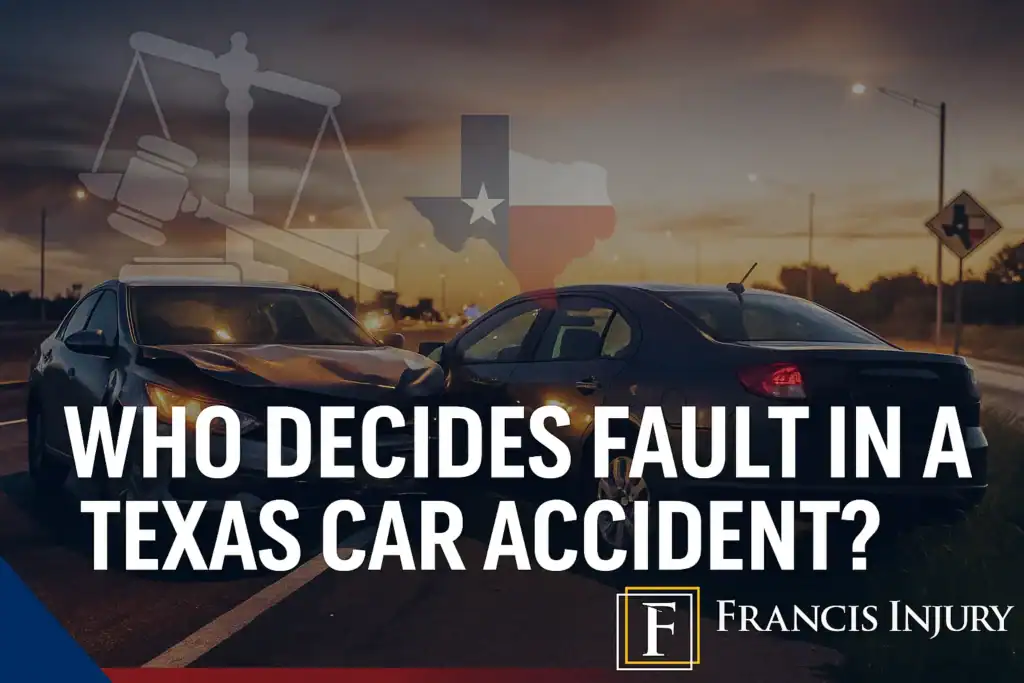
After a car accident in Texas, one of the first questions victims ask is: “Who decides who was at fault?” Fault is more than a matter of blame — in Texas, which is a fault-based state, the answer determines whose insurance pays for damages, medical bills, and compensation. The process can feel confusing because fault isn’t decided by just one party. Instead, multiple entities — police officers, insurance adjusters, and, in some cases, judges and juries — play a role in determining liability. In this guide, we’ll break down how fault is decided, what role evidence and traffic laws play, how comparative negligence affects recovery, and why having a skilled attorney can make a critical difference in protecting your claim.
Texas Is a Fault-Based State
Texas follows a fault-based insurance system, also known as a tort system. This means the driver responsible for causing an accident is financially liable for the resulting damages. Drivers in Texas must carry minimum liability insurance — at least $30,000 per person, $60,000 per accident for bodily injury, and $25,000 for property damage. This requirement, set by the Texas Department of Insurance, ensures that at-fault drivers have coverage to pay for injuries and damage they cause.
In practice, this means proving fault is essential. If you’re injured in a crash that wasn’t your fault, you may file a claim against the other driver’s insurance. Alternatively, you may use your own PIP coverage or uninsured/underinsured motorist coverage if the at-fault driver lacks sufficient insurance. Unlike no-fault states, where drivers look to their own insurers first, Texans must establish fault to determine who pays. That’s why understanding how fault decisions are made — and who makes them — is so important after a crash.
The Role of Police in Determining Fault
When an accident occurs, police officers are often the first authority figures at the scene. They secure the site, gather information, and prepare a formal Texas Peace Officer’s Crash Report (CR-3). This report typically includes:
- Driver and witness statements
- Descriptions of vehicle damage and final resting positions
- Roadway and weather conditions
- Traffic law violations or citations issued
Police reports are highly influential. If an officer cites a driver for running a red light, failing to yield, or following too closely, insurance adjusters and courts often treat that citation as strong evidence of fault. However, the police report is not the final word on liability. Officers usually arrive after the fact and must reconstruct events based on limited information. If one driver is taken to the hospital and can’t give a statement, the report may reflect only one side of the story. That’s why, while police findings carry weight, fault can still be disputed later during insurance negotiations or in court. Learn more about how reports and other documentation affect fault in our guide to evidence in car accident cases.
The Role of Insurance Adjusters
Most fault determinations in Texas car accidents occur during the insurance claims process. Insurance adjusters for each driver’s insurance company investigate the crash. Their process typically includes reviewing police reports, interviewing drivers and witnesses, inspecting vehicle damage, and analyzing photographs or video.
While adjusters seem like neutral investigators, remember they work for insurance companies whose goal is to minimize payouts. Common tactics include:
- Requesting recorded statements early, hoping you’ll say something that suggests partial blame.
- Cherry-picking evidence that supports denying or reducing your claim.
- Arguing comparative negligence to reduce compensation by assigning you a share of fault.
This is where many accident victims face challenges. Even if the facts are clear, insurers may still dispute liability or argue you were partly responsible. For example, in a rear-end collision, the trailing driver is usually at fault, but an adjuster might claim you “stopped suddenly” to assign partial blame. Learn how to protect yourself in our article on dealing with insurance companies after a car accident.
How Texas Traffic Laws Influence Fault
Texas traffic laws, found in the Texas Transportation Code, serve as benchmarks for determining safe driving. When a driver violates a traffic law and causes an accident, that violation is strong evidence of negligence. This concept is called negligence per se — meaning the act itself establishes liability.
Examples include:
- Rear-end collisions often result from violating the rule to maintain a safe following distance.
- Left-turn crashes usually involve failure to yield to oncoming traffic.
- T-bone collisions commonly occur when a driver runs a stop sign or red light.
Even if police don’t issue a ticket, insurers and courts can use evidence (like dashcam footage or witness testimony) to determine a driver violated traffic laws. When both drivers break the rules, fault can be shared. Explore more scenarios in our article on accidents caused by poor road conditions.
When Courts and Juries Decide Fault
If insurance companies cannot agree or a fair settlement cannot be reached, disputes move to the courtroom. In Texas, a judge or jury ultimately decides fault by weighing all evidence. This process may involve:
- Accident reconstruction experts
- Witness testimony under oath
- Review of police reports, photos, and videos
- Medical experts describing injury causation
Juries can assign percentages of blame to multiple drivers. For example, they might find one driver 70% responsible and the other 30% responsible. This breakdown directly impacts how much compensation is awarded under Texas’s comparative negligence law. While most cases settle before trial, the possibility of a jury decision often motivates insurers to negotiate more fairly.
Comparative Negligence: The 51% Bar Rule
Texas applies a modified comparative negligence standard, commonly called the 51% Bar Rule. Here’s what it means:
- If you are 50% or less at fault, you can recover damages, reduced by your percentage of responsibility.
- If you are 51% or more at fault, you are barred from any recovery.
For example, if your damages are $100,000 but you’re found 20% at fault, you can recover $80,000. If you’re found 51% at fault, you recover nothing. This makes insurers eager to assign blame to victims, even partially, to reduce or eliminate payouts. Understanding this rule is critical, which we explain further in our blog on comparative negligence in Texas.
Common Accident Scenarios and Fault Patterns
Fault is often clear in certain types of accidents. Here are common scenarios:
- Rear-end collisions: The trailing driver is usually at fault for following too closely.
- Left-turn accidents: Left-turning drivers must yield to oncoming traffic.
- T-bone collisions: Often caused by running a stop sign or red light.
- Chain-reaction pileups: Typically the first driver to collide bears most responsibility, but fault can be shared.
- Weather-related accidents: Drivers must adjust their speed and behavior to conditions — bad weather is not a defense.
For a deeper dive into specific scenarios, read our detailed post on rear-end collisions.
Evidence That Influences Fault
Strong evidence often decides fault disputes. Key evidence includes:
- Police accident reports: These carry weight but can be challenged.
- Traffic citations: A ticket for running a red light or speeding is powerful proof of fault.
- Witness statements: Independent accounts often tip the scales.
- Photos and videos: Dashcams, traffic cameras, and smartphone videos can be decisive.
- Event Data Recorders (EDRs): Modern cars capture speed, braking, and steering inputs in the seconds before a crash.
- Medical records: Injury patterns can corroborate impact direction and severity.
Want to know what to gather after a wreck? See our guide on evidence in Texas car accident claims.
The Importance of Legal Representation
Because insurers and courts weigh evidence differently, legal representation is critical. An experienced Texas personal injury lawyer will:
- Conduct an independent investigation beyond the police report
- Protect you from insurance company tactics
- Challenge unfair fault allocation under comparative negligence
- Negotiate liens and medical bills
- Maximize your compensation through settlement or trial
For more insight, read our resource on Texas car accident claims. At Francis Injury, our attorneys know how to ensure fault is properly assigned and that clients receive full, fair compensation.
Free Consultation With a Texas Car Accident Lawyer
Can’t see the map? Open in Google Maps.
FAQ: Fault in Texas Car Accidents
Do police officers decide fault in Texas accidents?
Can the at-fault driver’s insurance deny liability?
What if both drivers are partly at fault?
Does a traffic ticket make me automatically at fault?
How do adjusters figure out fault?
What if the insurer denies fault completely?
Can I recover damages if I was partly at fault?
What evidence is most persuasive?
Does Texas have no-fault car insurance?
Why hire a lawyer if fault seems clear?
- Understanding Truck Accident Insurance Coverage: A Complete 2025 Guide for Texas Accident Victims
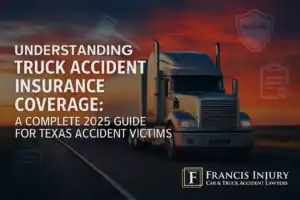
- Who Decides Fault in a Texas Car Accident?

- Who Pays Your Medical Bills After a Car Accident in Texas?
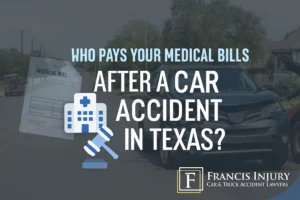
- How Weather Conditions Affect Car Accident Liability in Texas

- Common Causes of Lower Back Pain After a Car Accident (2025 Guide)
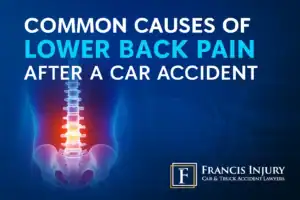
- Truck Accident Negligence
